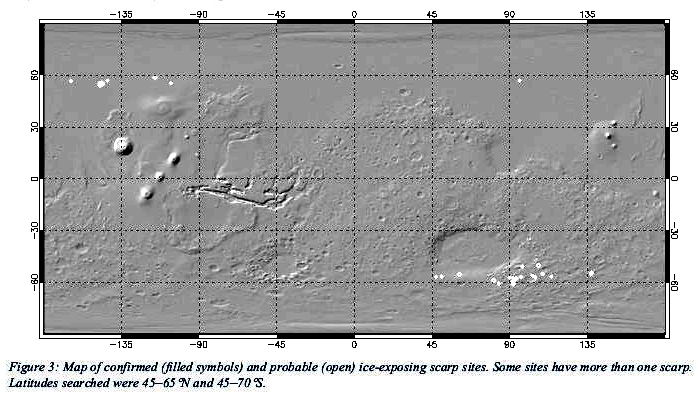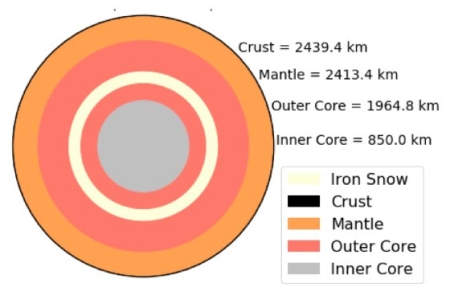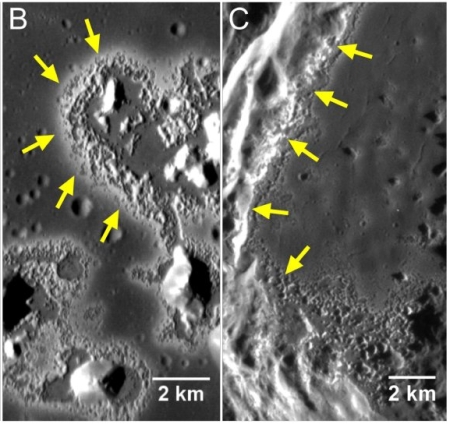Friday at the non-existent Lunar & Planetary Science Conference

Today was supposed to have been the last day at the cancelled 51st annual Lunar & Planetary Science conference. As such, only a half day of presentations had been scheduled in order to give participants the option of returning home sooner.
While many of the abstracts of the planned-but-now-cancelled presentations were on subjects important to the scientists but not so interesting to the general public, two sessions, one on Martian buried glaciers/ice and a second focused on Mercury, would have made the day very worthwhile to this science journalist, had I been there.
The map above, from the first abstract [pdf] of the Mars session, might possibly epitomize our present knowledge of ice/glaciers on Mars. It provides an update of the continuing survey of ice scarps in the high mid-latitudes of Mars (see the most recent post on Behind the Black from February 12, 2020). Clearly, the more they look, the more they find of these ice scarps, cliff faces with visible exposed pure ice layers that will be relatively easy to access.
But then, finding evidence of some form of buried ice on Mars is becoming almost routine. Of the thirteen abstracts in this Mars session, ten described some sort of evidence of buried ice or glaciers on Mars, in all sorts of places, with the remaining three abstracts studying similar Earth features for comparison. The scientists found evidence of water ice on the top of one of Mars’ largest volcanoes (abstract #2299 [pdf]), in faults and fissures near the equator (#1997 [pdf]), in the eastern margin of one of Mars’ largest deep basins (#3070 [pdf]), in Gale Crater (#2609 [pdf]), in the transition zone between the northern lowlands and southern highlands (#1074 [pdf]), and of course in the northern mid-latitude lowland plains (#2648 [pdf] and #2872 [pdf]).
The results tell us not that there is water ice on Mars, but that it is very plentiful, and that its presence and behavior (as glaciers, as snowfall, and as an underground aquifer) make it a major factor in explaining the geology we see on Mars. I’ve even begun to get a sense that among the planetary scientists researching Mars there is an increasing consideration that maybe ice formed many of the river-like features we see on the surface, not flowing water as has been assumed for decades. This theory has not yet become dominate or even popular, but I have been seeing mention of it increasingly in papers, in one form or another.
If this possibility becomes accepted, it would help solve many Martian geological mysteries, primary of which is the fact that scientists cannot yet explain how water flowed as liquid on the surface some time ago in Mars’ long geological history, given its theorized atmosphere and climate. If ice did the shaping, then liquid water (in large amounts) would not be required.
Now, on to the Mercury session.
There were several basic topics covered, as follows:

- Mercury’s interior structure is not really understood. They think its mantle is thin and its core is large, but as one abstract [pdf] noted, “the structure of Mercury’s interior remains ambiguous and still leaves room for speculation.” The carton model to the right comes from that paper, and is a best guess based on present knowledge, with many uncertainties.
- Though Mercury and the Moon appear superficially the same, there are some fundamental differences. For one, Mercury is darker, for reasons that are not understood. Two abstracts (#1859 [pdf] and #2873 [pdf]) looked at whether carbon in some form could explain the difference.
- Another abstract [pdf] did a census of the 104 volcanic vents on the planet, thought to be evidence of explosive volcanism some time in the relatively recent geological past. Interestingly, 82% of these vents are found in craters, and in general they are not associated with Mercury’s mare volcanic plains.
- New research [pdf] into the possibility of ice in the permanently shadowed craters at Mercury’s poles focused at one polar crater, Ensor, finding that instead of ice the crater might contain “complex organic volatile compounds.” (This is not life, but complex molecules that include carbon.)
- A comparison [pdf] of the craters and their degradation over time on the Moon and Mercury found that the regolith on Mercury is probably thicker, by as much as 8 to 20 meters.

Finally, there is the image to the right, taken from one abstract [pdf] researching the formation of what scientists call hollows on Mercury. As the abstract notes:
Hollows are irregularly-shaped small rimless shallow depressions on Mercury that are usually associated with high-reflectance haloes. Hollows are likely formed by loss of volatile-bearing phase in surface materials via possibly sublimation process, and they are possibly still activate
In other words, some material in the ground changes from a solid to a gas (sublimates), creating voids that eventually collapse to create the hollow as well as the bright surface that surrounds it.
In the image, the arrows in B indicate the high-reflectance halo on the hollow rim. In C the arrows indicate the interior base of the crater wall where these hollows are found.
The abstract also notes that “there is no consensus in previous studies about the possible nature of volatiles that formed the hollows.” The present paper does not solve this question either, though it provides further constraints that might help solve it eventually.
With this report, the non-existent Lunar & Planetary Conference has ended (even though it never really started). I will likely follow up with the scientists for some of these stories to get a bit more background and information. Some of these abstracts absolutely demand it, and would have gotten that attention now if the world had not gone bonkers over a virus that I will once again predict will become just another variation of the flu.
On Christmas Eve 1968 three Americans became the first humans to visit another world. What they did to celebrate was unexpected and profound, and will be remembered throughout all human history. Genesis: the Story of Apollo 8, Robert Zimmerman's classic history of humanity's first journey to another world, tells that story, and it is now available as both an ebook and an audiobook, both with a foreword by Valerie Anders and a new introduction by Robert Zimmerman.
The print edition can be purchased at Amazon or from any other book seller. If you want an autographed copy the price is $60 for the hardback and $45 for the paperback, plus $8 shipping for each. Go here for purchasing details. The ebook is available everywhere for $5.99 (before discount) at amazon, or direct from my ebook publisher, ebookit. If you buy it from ebookit you don't support the big tech companies and the author gets a bigger cut much sooner.
The audiobook is also available at all these vendors, and is also free with a 30-day trial membership to Audible.
"Not simply about one mission, [Genesis] is also the history of America's quest for the moon... Zimmerman has done a masterful job of tying disparate events together into a solid account of one of America's greatest human triumphs."--San Antonio Express-News


I can see no obvious problems with your glacier theory, a build up of enough ice will slide downhill. But if I , (and you) are reading the photos from the last 15 earth years correctly, there are distinct geological layers, many, many years separating them, meters deep…A rock layer… Then an ice layer… Then a rock layer….
The water ice seems to be high up in the strata… Although ancient, not so much compared to the strata below… All good news for future colonists, but did/have you seen any theories how this could be possible?… It leaves me scratching my head…
Lee S: I wish you would read my posts about Mars more closely. I have addressed this question a number of times. The layering on Mars is almost certainly related to the swings in the planet’s inclination. See all the posts in this BtB search.
Or read this post, where I specifically discuss the subject: Buried glaciers flowing off of Martian mesa
This cyclical process certainly could have caused the layering. Makes perfect sense.
Excellent!
When it comes to mercury and mars, nothing is as simple as it appears. There’s always more questions than answers.
As Bob often notes, the northern hemisphere, which is relatively flat on Mars, is lower than southern rough hemisphere. Yes it could’ve been an ocean, most likely it is the largest impact crater in the solar system. The crust would be fractured miles deep.
A second impact craters, Helena’s basin, was so violent and deep that it pushed up tharsis bulge on the other side of the planet. Four of the resulting giant volcanoes pushed out enough lava to cover continents. And probably enough gas to create a thick warm atmosphere… If temporary. Oceans or ice would have melted and seeped into those deep crevices and regolith.
Ever since I saw the average air pressure on Mars near 7 millibars, I knew it wasn’t a coincidence. The threshold for water ice boiling into a gas.
When the atmosphere gets too thin, the water evaporates maintaining the air pressure until the water is all gone. This is evidence of water still existing under the surface.
As for Mercury, it is much too dense for its size. How could it have such a large iron core? I like the theory that it was once a gas giant that passed through the sun and lost its momentum and atmosphere. I know, a fantasy… Core samples would verify from normal, or exotic materials under the surface. I still believe it is the most habitable planet second only to the moon in resources and energy. At 1/2 an astronomical unit away, with a thick atmosphere “Venus” for aerobraking, it’s only a few months away as compared to the astroid belt at three astronomical units or Jupiter and its moons at five astronomical units. Whoever goes out there won’t be coming back (until they’re very old)
Bob Z, while I might not read everything you write on politics, I certainly do on planetary geologist matters, and I’m aware of the theory that movements in the inclination of Mars would cause liquid/freezing cycles, I’m inclined to agree with you! ( Admit it… That was a half decent pun!), And glacier flow is obvious, indeed probably still occuring.
My curiosity is poked by where did the water come from?
These layers seem to be planet wide, and many meters deep…. do you have any theory how several layers of relativity pure water ice can be layered between relatively thick layers of rock? It’s a remarkably defined set of strata… So did the water on one side settle as ice, then did the water on the other side settle, then some event layed down the rock layer, then the water on the other side freeze… Oh, hang on… It’s already been frozen and covered in some form of ejecta.
I wish YOU would consider a pertinent question before refering to your previous posts…. As far as I know, nothing had been published on any REAL mechanism how these strata were laid down.
@ Max…. a decent theory… But I still don’t buy it…. It would have taken many catastrophic events to create this many levels of strata… Remember ice floats…. I can’t imagine any event which would vaporise all the liquid, without melting the surface ice, let that ice settle, have time to be covered in ejecta, etc…
Mercury could in theory be mined… Humans could no doubt live just over the border of night and day, and utilise the temperature gradient for almost unlimited power… But as you say… Getting out of the gravity well would be hard work!
Lee S: I have not yet seen any theoretical models attempting to explain the layering. I suspect this is because we do not yet have enough data to put one together. We see layering and we see that some layers appear to be water ice, but this is about all we know. We do know know the extent globally of these ice tables underground (how close to the equator you might find them), we do not know their thickness or age, we do not know the thickness or age of all adjacent layers, and we do not know their extent.
Essentially it is too soon to make any theories on the cause of the layering that has been seen. The focus now is on gathering data, most of which must be done very remotely, making any conclusions of what we see somewhat tentative also. For example, the many glaciers I write about are buried, and most have not been confirmed as water. They might not be, though the data suggests they are.
@Bob…. Every once in a while we are in total agreement!!!
I’m a little versed in geology, ( as I know you are!) and given Mars’s apparent lack of tectonic activity, there is no wonder we see so many different strata…. It’s been laid down over litteraly billions of years…. It’s just those bloody strata of ice that keep me awake at night! I just cannot wrap my head around any process that could leave such multiple, thick strata of ice in place, virtualy untouched, and relatively young, as they always seem to be high up in the bedding.
I hope that little drone attached to perceiverance works… What work could be done with an up close and personal look at that bedding!!!